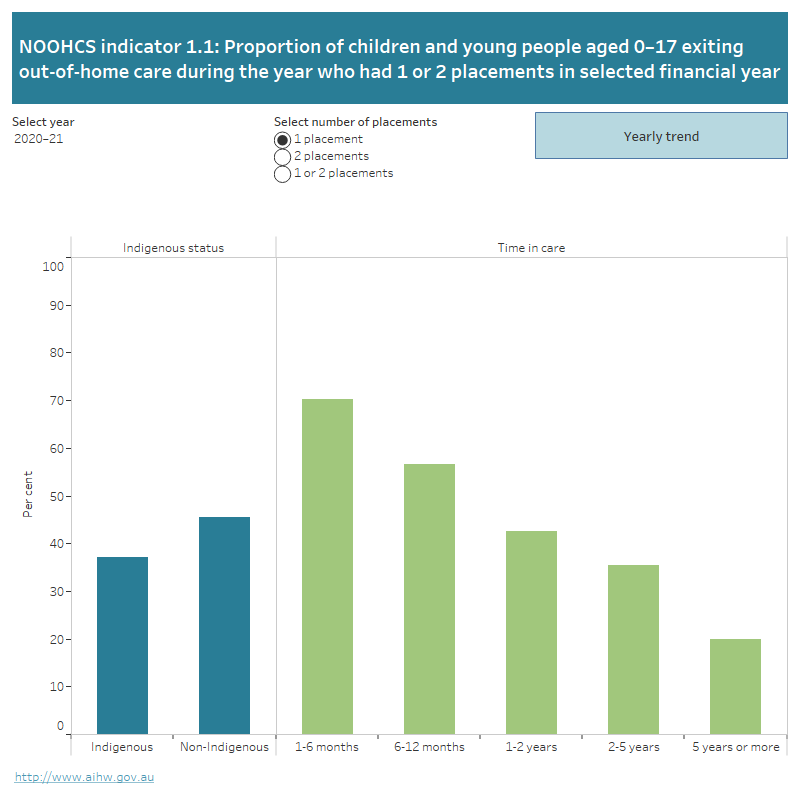1.1 Stability
This indicator measures the same outcome as NFPAC Indicator 4.2 and therefore both indicators report the same numbers.
Care should be taken when interpreting the time series for this indicator, as it has been affected by the implementation of the national definition of out-of-home care.
As of 2019, all states and territories have adopted a nationally consistent definition of out-of-home care which excludes children on third-party parental responsibility orders, children on immigration orders, young people aged 18 and over, and children in pre-adoptive placements from counts of children in out-of-home care.
Out-of-home care data from the 2018–19 reporting period onwards are based on this nationally agreed definition and, where possible, back cast to 2016–17. These should not be compared with data for previous years or previously published out-of-home care data.
For more information on the national definition of out-of-home care, see Child protection Australia 2018–19.
Children in planned, stable out-of-home care placements tend to have better learning and psychosocial outcomes than children experiencing instability (Campo and Commerford 2016).
Children who have had only 1 or 2 placements prior to exiting out-of-home care provides a broad indicator of stability.
Children can have multiple short-term placements for appropriate reasons (for example, an initial placement followed by a longer-term placement), or it may be desirable to change placements to achieve better compatibility between a child and family. Older children are more likely to have multiple placements as they move towards independence and voluntarily seek alternate placements.
Trend data: For all indicator displays, the yearly trend is limited to indicators with 3 or more years (including the current year) of comparable time series data. To see the trend click on 'Yearly Trend' button on the display. Where 3 or more years of comparable data including the most recent year is not available, a “No time series data” message is shown on the display.
The first figure is a bar graph showing the proportion of children and young people aged 0–17 exiting out-of-home care during the year who had 1 or 2 placements by Indigenous status and time in care. Data can be selected by year from 2009–10 to 2020–21. Data can also be selected by number of placements.
The second figure is a line graph showing the proportion of children and young people aged 0–17 exiting out-of-home care during the year who had 1 or 2 placements from 2016–17 to 2020–21. Data can be selected by Indigenous status, time in care or number of placements.

Source: AIHW Child Protection Collection
See the supplementary data tables for further information and footnotes about these data.
References
Campo M and Commerford J (2016) Supporting young people leaving out-of-home care, Australian Institute of Family Studies, Australian Government, accessed 13 May 2020.
Indicator technical specifications
The information below provides technical specifications for the summary indicator data presented in the quick reference guide.
| Definition | Data source | |
|---|---|---|
| Numerator | Number of children aged 0-17 years exiting out-of-home care in the reference period who had one or two placements during a period of continuous out-of-home care, and who had been in care for at least 30 days, and were also on a care and protection order at some point 180 days prior to exiting care | AIHW National Child Protection Data Collection |
| Denominator | Number of children aged 0-17 years exiting out-of-home care in the reference period who were on a care and protection order at some point 180 days prior to exiting care | AIHW National Child Protection Data Collection |
Explanatory notes
These data capture children who exited out-of-home care in the reference period who had been in care for at least 30 days, were on a care and protection order at some point 180 days prior to exiting care, and did not return within 60 days. It captures the number of placements during the period the child was in continuous out-of-home care (from entry to exit). Each placement is only counted once, and a return to a previous placement is not counted as a different placement.
Differences in legislation, policies and practices in relation to out-of-home care across jurisdictions and over time can affect the number and rate of children in out-of-home care so caution must be taken when interpreting the data.


